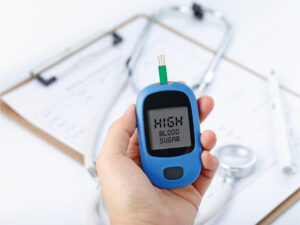
Why Sports & Physical Activity Are Important For Children With Diabetes
January 19, 2022
Diabetic Macular Edema: How This Common Diabetic Eye Disease Can Be Detected
January 19, 2022Traditionally, liver disease was most strongly associated with high alcohol intake, but recent decades have also seen an increase in cases of non-alcoholic fatty liver disease. While this condition can develop in anyone, including those who have never consumed alcohol, it is often observed in patients who also suffer from diabetes. Non-alcoholic fatty liver disease refers to a group of conditions that involve the accumulation of fat deposits in the liver, which triggers inflammation and causes enlargement or swelling of the liver. If not detected and treated effectively it can progressively worsen, leading to life-threatening conditions such as fibrosis or cirrhosis of the liver.
Diabetes & The Risk Of Fatty Liver Disease
Diabetes itself is not a cause for fatty liver disease, but is associated with a higher risk of the condition. This is because both diseases have many common risk factors, such as excess body weight or obesity, insulin resistance, high cholesterol levels, and so on. At the same time, diabetes may itself develop as a result of liver disease – as fat accumulates in the liver, it can make the organ less efficient at storing or releasing glucose in response to insulin. The resultant insulin resistance can then cause blood sugar levels to rise and result in the onset of type 2 diabetes.

Unfortunately, type 2 diabetes can increase the risk of more serious complications associated with non-alcoholic fatty liver disease, such as nonalcoholic steatohepatitis or NASH. This is a condition in which fat in the liver triggers inflammation, which causes an accumulation of scar tissue in the region. As scar tissue continues to accumulate over time, it results in liver cirrhosis or end-stage liver disease. Some estimates suggest that as many as three out of four diabetes patients may have excess fat buildup in the liver and half of these patients may also have inflammation and scarring of the liver. However, most patients will remain unaware of the presence of fatty liver disease in the early stages because of the absence of clear symptoms.
This is why routine health checks that are part of diabetes care are so important. Liver enzyme tests are actually a part of the routine blood tests conducted during diabetes health checks. This is how the vast majority of fatty liver disease cases are diagnosed in diabetes patients. In some cases, physical examinations or imaging tests such as abdominal or liver ultrasounds and CT scans may reveal the condition.
Protecting Your Liver Against Fatty Liver Disease
Although type 2 diabetes and fatty liver disease are closely associated, a diagnosis of diabetes does not necessarily mean that you will develop fatty liver disease. Many of the risk factors for fatty liver disease are also the same factors that increase the risk of diabetes and diabetic complications. Simply addressing these risk factors can help protect against fatty liver disease. This means that making healthy diet and lifestyle changes to fight obesity, lower triglyceride levels, improve insulin sensitivity, and maintain healthy blood sugar levels will not only aid diabetes control, but will also help in the prevention of fatty liver disease.




